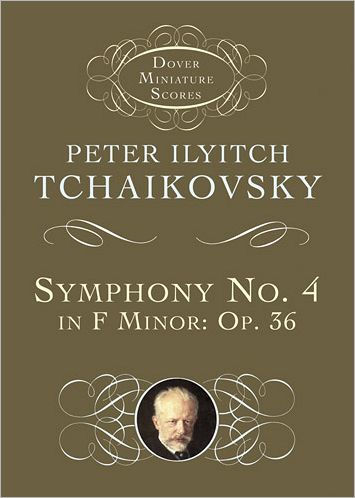Symphony No. 4
In Tchaikovsky's symphonic output, his Symphony No. 4 was a pivotal work. It announced the composer as a major symphonist of his time, overshadowing his previous, less-than-distinguished efforts in this form, and opened the way to his last, major, works: the haunting Fifth Symphony and the biographical Sixth, the profound "Pathétique."
Tchaikovsky's Fourth Symphony — written in 1877 at the age of thirty-seven — offers itself as an intensely personal statement. Dramatically shaped and brilliantly orchestrated, it captures a theatrical quality and orchestral color that shaped the composer's symphonic fantasy Francesca da Rimini, written just a year earlier. The Fourth opens unequivocally with the thrust of a brass fanfare — the "fate" motive that is to reappear in the last movement — then flows with the effortless quality that characterizes Tchaikovsky's great, generously melodious ballet scores. The second movement lingers over one of the composer's most poignant melodies, and the third — the Scherzo — offers a delightful fantasy from this master orchestrator: the charming Pizzicato ostinato, a unique moment in the entire orchestral literature.
The symphony is reproduced here from the authoritative Breitkopf & Härtel edition, with bar-numbered movements and ample margins at the bottom of each score page for notes and analysis. Ideal for study in the classroom, at home, or in the concert hall, this affordable, high quality, conveniently sized volume will be the edition of choice for music students and music lovers alike
"1018193952"
Tchaikovsky's Fourth Symphony — written in 1877 at the age of thirty-seven — offers itself as an intensely personal statement. Dramatically shaped and brilliantly orchestrated, it captures a theatrical quality and orchestral color that shaped the composer's symphonic fantasy Francesca da Rimini, written just a year earlier. The Fourth opens unequivocally with the thrust of a brass fanfare — the "fate" motive that is to reappear in the last movement — then flows with the effortless quality that characterizes Tchaikovsky's great, generously melodious ballet scores. The second movement lingers over one of the composer's most poignant melodies, and the third — the Scherzo — offers a delightful fantasy from this master orchestrator: the charming Pizzicato ostinato, a unique moment in the entire orchestral literature.
The symphony is reproduced here from the authoritative Breitkopf & Härtel edition, with bar-numbered movements and ample margins at the bottom of each score page for notes and analysis. Ideal for study in the classroom, at home, or in the concert hall, this affordable, high quality, conveniently sized volume will be the edition of choice for music students and music lovers alike
Symphony No. 4
In Tchaikovsky's symphonic output, his Symphony No. 4 was a pivotal work. It announced the composer as a major symphonist of his time, overshadowing his previous, less-than-distinguished efforts in this form, and opened the way to his last, major, works: the haunting Fifth Symphony and the biographical Sixth, the profound "Pathétique."
Tchaikovsky's Fourth Symphony — written in 1877 at the age of thirty-seven — offers itself as an intensely personal statement. Dramatically shaped and brilliantly orchestrated, it captures a theatrical quality and orchestral color that shaped the composer's symphonic fantasy Francesca da Rimini, written just a year earlier. The Fourth opens unequivocally with the thrust of a brass fanfare — the "fate" motive that is to reappear in the last movement — then flows with the effortless quality that characterizes Tchaikovsky's great, generously melodious ballet scores. The second movement lingers over one of the composer's most poignant melodies, and the third — the Scherzo — offers a delightful fantasy from this master orchestrator: the charming Pizzicato ostinato, a unique moment in the entire orchestral literature.
The symphony is reproduced here from the authoritative Breitkopf & Härtel edition, with bar-numbered movements and ample margins at the bottom of each score page for notes and analysis. Ideal for study in the classroom, at home, or in the concert hall, this affordable, high quality, conveniently sized volume will be the edition of choice for music students and music lovers alike
Tchaikovsky's Fourth Symphony — written in 1877 at the age of thirty-seven — offers itself as an intensely personal statement. Dramatically shaped and brilliantly orchestrated, it captures a theatrical quality and orchestral color that shaped the composer's symphonic fantasy Francesca da Rimini, written just a year earlier. The Fourth opens unequivocally with the thrust of a brass fanfare — the "fate" motive that is to reappear in the last movement — then flows with the effortless quality that characterizes Tchaikovsky's great, generously melodious ballet scores. The second movement lingers over one of the composer's most poignant melodies, and the third — the Scherzo — offers a delightful fantasy from this master orchestrator: the charming Pizzicato ostinato, a unique moment in the entire orchestral literature.
The symphony is reproduced here from the authoritative Breitkopf & Härtel edition, with bar-numbered movements and ample margins at the bottom of each score page for notes and analysis. Ideal for study in the classroom, at home, or in the concert hall, this affordable, high quality, conveniently sized volume will be the edition of choice for music students and music lovers alike
7.95
In Stock
5
1

Symphony No. 4
160
Symphony No. 4
160Paperback
$7.95
7.95
In Stock

Product Details
| ISBN-13: | 9780486404219 |
|---|---|
| Publisher: | Dover Publications |
| Publication date: | 06/13/2012 |
| Series: | Dover Miniature Music Scores Series |
| Pages: | 160 |
| Sales rank: | 681,391 |
| Product dimensions: | 6.22(w) x 8.68(h) x 0.44(d) |
About the Author
From the B&N Reads Blog
